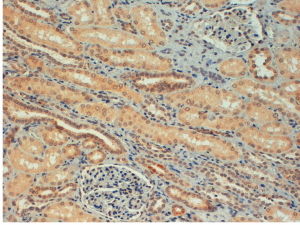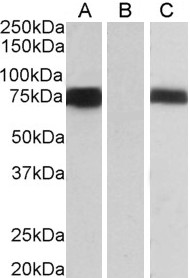Goat Anti-FOXC1 (C Term) Antibody
Peptide-affinity purified goat antibody
- SPECIFICATION
- CITATIONS
- PROTOCOLS
- BACKGROUND

Application
| WB, IHC, E |
|---|---|
| Primary Accession | Q12948 |
| Other Accession | NP_001444, 2296, 17300 (mouse) |
| Reactivity | Human, Mouse, Zebrafish |
| Host | Goat |
| Clonality | Polyclonal |
| Concentration | 100ug/200ul |
| Isotype | IgG |
| Calculated MW | 56789 Da |
| Gene ID | 2296 |
|---|---|
| Other Names | Forkhead box protein C1, Forkhead-related protein FKHL7, Forkhead-related transcription factor 3, FREAC-3, FOXC1, FKHL7, FREAC3 |
| Target/Specificity | Western blot: In transfected HEK293 transiently expressing full-length Human FOXC1 (myc and DYKDDDDK tagged), a band of approx. 75kDa was observed. No bands were observed in mock-transfected and the same band was observed using anti-DYKDDDDK tag antibody. Recommended concentration, 0.5-1µg/ml. An anonymous customer found positive results in WB on Human breast cancer cells (T47D). IHC: In paraffin embedded Human Kidney shows nuclear staining in DCT and select nuclear staining in the glomerulus. Recommended concentration, 4-6µg/ml. Customer successfully used in IHC-P in mouse (periocular mesenchyme, cornea) |
| Dilution | WB~~1:1000 IHC~~1:100~500 E~~N/A |
| Format | 0.5 mg IgG/ml in Tris saline (20mM Tris pH7.3, 150mM NaCl), 0.02% sodium azide, with 0.5% bovine serum albumin |
| Storage | Maintain refrigerated at 2-8°C for up to 6 months. For long term storage store at -20°C in small aliquots to prevent freeze-thaw cycles. |
| Precautions | Goat Anti-FOXC1 (C Term) Antibody is for research use only and not for use in diagnostic or therapeutic procedures. |
| Name | FOXC1 |
|---|---|
| Synonyms | FKHL7, FREAC3 |
| Function | DNA-binding transcriptional factor that plays a role in a broad range of cellular and developmental processes such as eye, bones, cardiovascular, kidney and skin development (PubMed:11782474, PubMed:14506133, PubMed:14578375, PubMed:15277473, PubMed:15299087, PubMed:15684392, PubMed:16449236, PubMed:16492674, PubMed:17210863, PubMed:19279310, PubMed:19793056, PubMed:25786029, PubMed:27804176, PubMed:27907090). Acts either as a transcriptional activator or repressor (PubMed:11782474). Binds to the consensus binding site 5'- [G/C][A/T]AAA[T/C]AA[A/C]-3' in promoter of target genes (PubMed:11782474, PubMed:12533514, PubMed:14506133, PubMed:19793056, PubMed:27804176, PubMed:7957066). Upon DNA-binding, promotes DNA bending (PubMed:14506133, PubMed:7957066). Acts as a transcriptional coactivator (PubMed:26565916). Stimulates Indian hedgehog (Ihh)-induced target gene expression mediated by the transcription factor GLI2, and hence regulates endochondral ossification (By similarity). Also acts as a transcriptional coregulator by increasing DNA-binding capacity of GLI2 in breast cancer cells (PubMed:26565916). Regulates FOXO1 through binding to a conserved element, 5'-GTAAACAAA-3' in its promoter region, implicating FOXC1 as an important regulator of cell viability and resistance to oxidative stress in the eye (PubMed:17993506). Cooperates with transcription factor FOXC2 in regulating expression of genes that maintain podocyte integrity (By similarity). Promotes cell growth inhibition by stopping the cell cycle in the G1 phase through TGFB1- mediated signals (PubMed:12408963). Involved in epithelial-mesenchymal transition (EMT) induction by increasing cell proliferation, migration and invasion (PubMed:20406990, PubMed:22991501). Involved in chemokine CXCL12-induced endothelial cell migration through the control of CXCR4 expression (By similarity). Plays a role in the gene regulatory network essential for epidermal keratinocyte terminal differentiation (PubMed:27907090). Essential developmental transcriptional factor required for mesoderm-derived tissues, such as the somites, skin, bone and cartilage. Positively regulates CXCL12 and stem cell factor expression in bone marrow mesenchymal progenitor cells, and hence plays a role in the development and maintenance of mesenchymal niches for haematopoietic stem and progenitor cells (HSPC). Plays a role in corneal transparency by preventing both blood vessel and lymphatic vessel growth during embryonic development in a VEGF-dependent manner. Involved in chemokine CXCL12-induced endothelial cell migration through the control of CXCR4 expression (By similarity). May function as a tumor suppressor (PubMed:12408963). |
| Cellular Location | Nucleus Note=Colocalizes with PITX2 isoform 3 in the nucleus at subnuclear chromatine regions (PubMed:16449236). Colocalizes with CBX5 to a heterochromatin-rich region of the nucleus (PubMed:15684392) Colocalizes with GLI2 in the nucleus (By similarity) {ECO:0000250|UniProtKB:Q61572, ECO:0000269|PubMed:15684392, ECO:0000269|PubMed:16449236} |
| Tissue Location | Expressed in keratinocytes of epidermis and hair follicle (PubMed:27907090). Expressed strongly in microvascular invasion (MVI) formation, basal-like breast cancer (BLBC) and hepatocellular tumors (PubMed:20406990, PubMed:22991501). Expressed in breast cancers (at protein level) (PubMed:26565916). Expressed in hematopoietic cells (PubMed:8499623). |

Thousands of laboratories across the world have published research that depended on the performance of antibodies from Abcepta to advance their research. Check out links to articles that cite our products in major peer-reviewed journals, organized by research category.
info@abcepta.com, and receive a free "I Love Antibodies" mug.
Provided below are standard protocols that you may find useful for product applications.
Background
This gene belongs to the forkhead family of transcription factors which is characterized by a distinct DNA-binding forkhead domain. The specific function of this gene has not yet been determined; however, it has been shown to play a role in the regulation of embryonic and ocular development. Mutations in this gene cause various glaucoma phenotypes including primary congenital glaucoma, autosomal dominant iridogoniodysgenesis anomaly, and Axenfeld-Rieger anomaly.
References
Variation at the NFATC2 Locus Increases the Risk of Thiazolinedinedione-Induced Edema in the Diabetes REduction Assessment with ramipril and rosiglitazone Medication (DREAM) Study. Bailey SD, et al. Diabetes Care, 2010 Jul 13. PMID 20628086.
A Large-scale genetic association study of esophageal adenocarcinoma risk. Liu CY, et al. Carcinogenesis, 2010 Jul. PMID 20453000.
FOXC1 is a potential prognostic biomarker with functional significance in basal-like breast cancer. Ray PS, et al. Cancer Res, 2010 May 15. PMID 20406990.
DNA methylation profiling in doxorubicin treated primary locally advanced breast tumours identifies novel genes associated with survival and treatment response. Dejeux E, et al. Mol Cancer, 2010 Mar 25. PMID 20338046.
Frequent aberrant DNA methylation of ABCB1, FOXC1, PPP2R2B and PTEN in ductal carcinoma in situ and early invasive breast cancer. Muggerud AA, et al. Breast Cancer Res, 2010. PMID 20056007.
If you have used an Abcepta product and would like to share how it has performed, please click on the "Submit Review" button and provide the requested information. Our staff will examine and post your review and contact you if needed.
If you have any additional inquiries please email technical services at tech@abcepta.com.













 Foundational characteristics of cancer include proliferation, angiogenesis, migration, evasion of apoptosis, and cellular immortality. Find key markers for these cellular processes and antibodies to detect them.
Foundational characteristics of cancer include proliferation, angiogenesis, migration, evasion of apoptosis, and cellular immortality. Find key markers for these cellular processes and antibodies to detect them. The SUMOplot™ Analysis Program predicts and scores sumoylation sites in your protein. SUMOylation is a post-translational modification involved in various cellular processes, such as nuclear-cytosolic transport, transcriptional regulation, apoptosis, protein stability, response to stress, and progression through the cell cycle.
The SUMOplot™ Analysis Program predicts and scores sumoylation sites in your protein. SUMOylation is a post-translational modification involved in various cellular processes, such as nuclear-cytosolic transport, transcriptional regulation, apoptosis, protein stability, response to stress, and progression through the cell cycle. The Autophagy Receptor Motif Plotter predicts and scores autophagy receptor binding sites in your protein. Identifying proteins connected to this pathway is critical to understanding the role of autophagy in physiological as well as pathological processes such as development, differentiation, neurodegenerative diseases, stress, infection, and cancer.
The Autophagy Receptor Motif Plotter predicts and scores autophagy receptor binding sites in your protein. Identifying proteins connected to this pathway is critical to understanding the role of autophagy in physiological as well as pathological processes such as development, differentiation, neurodegenerative diseases, stress, infection, and cancer.



